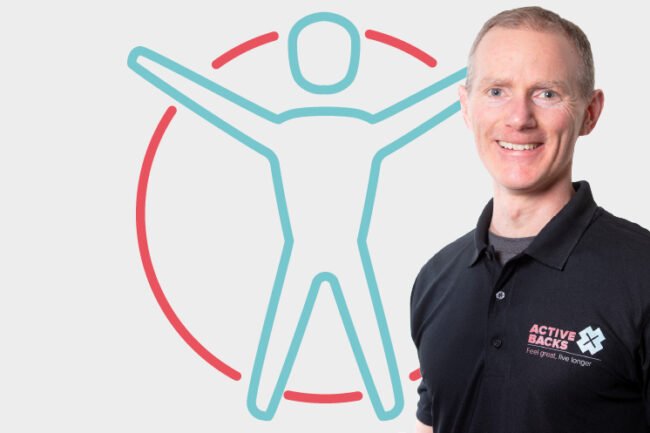This is the final pillar episode. If you haven’t listened to the five pillar episodes before this one, then do. Everything comes together when done in order. You’ll get value from every episode, but so much more value if you listen to episodes one to five before this one. In episode number six, ‘Why does my lower back hurt so much part two’, the grand unifying theory of pain will be presented. Although it’s less of a theory and more of an equation that sums up pain. Using variables such as the process of detecting pain, movement with pain, outlook, attention and previous pain.

The grand unifying theory of pain for your lower back hurt
Anyone who knows me will know – although maths isn’t my forte – I was a reasonable maths student and enjoy the odd equation. So I couldn’t resist the opportunity to create an equation for pain; my main passion! As we go through the equation for pain we will refer back to episode five, my story of being stung by a wasp. To help you understand how everything pieces together.
The equation
P = (N – MWP) + (NO – PO) + (ATBP) + (PVOP)
P
Pain at the beginning, as this is an equation for pain. The other P’s within the equation are not all for pain but will be discussed below.
N
P = (Nociception – MWP) + (NO – PO) + (ATBP) + (PVOP)
Nociception, is the process of detecting a potentially painful stimulus. When I was stung by the wasp, nerve endings (nociceptors) near the sting were triggered due to the toxin injected. Which sent an electrical impulse along the nerve towards my spinal cord. This triggered a pain response. So, there are no such thing as ‘pain nerves’. In effect we have different nerves that detect different stimuli. These make up what we call pain pathways. Simply, pain is not a hard wired system. If you push a button here, a bell rings there. It doesn’t work that way. It starts with nociception (if you would like to read more about the process of nociception once we have discussed this equation please click here).
MWP
P = (nociception – Movement Without Pain) + (NO – PO) + (ATBP) + (PVOP)
Movement Without Pain. Remember I was cycling and as my legs were going round I had less pain. When I wasn’t cycling, then I had more pain. Movement without pain is a really good thing. Movement with pain is not such a good thing. It’s important to move without causing pain to fire, as movement without pain has an inhibitory effect on pain pathways. Therefore, P = N – MWP, nociception minus movement without pain. Movement without pain decreases the variable that is nociception.
NO
Pain=(nociception – movement without pain) + (Negative Outlook – PO) + (ATBP) + (PVOP)
Negative outlook. When I was worried about getting an anaphylactic shock from my wasp sting, I had more pain. The more negative you are, the more pain you tend to feel. Rumination is the term used to describe this process, which actually is more to do with attention. If you ruminate, you’re thinking more and more about your problem. As you focus more on the pain it tends to be blown and up and magnified in your mind. Then as a result you feel more pain. In addition to this, those that have an anxious nature may ruminate more and tend to experience higher levels of pain than people who don’t.
PO
Pain=(nociception – movement without pain)+(negative outlook – Positive Outlook) + (ATBP) + (PVOP)
Positive outlook. The other end of the spectrum. People that are really positive don’t experience as much pain. So having a positive outlook is really beneficial in terms of reducing pain. After reminding myself that I am really fit and healthy, and was unlikely to suffer anaphylaxis due to a wasp sting, my pain started to decrease.
ATBP
Pain=(nociception – movement without pain)+(negative outlook – positive outlook)+ (Attention To Body Part) + (PVOP)
Attention to body part. This is linked to the idea of rumination. The more I thought about my leg, the more I noticed the pain. The less I thought about my leg, the less pain I experienced. Therefore, thinking about the body part causing pain leads to experiencing more pain in that area.
PVOP
Pain=(nociception – movement without pain)+(negative outlook – positive outlook) + (attention to body part) + (Previous Volume Of Pain)
Previous volume of pain. I don’t really have a reference point for this with regard to the wasp sting scenario. I’ve been stung before but not a huge amount. The scientific literature shows that the more pain you have experienced previously, particularly in a certain body part, but also globally, the more pain you are likely to suffer from. Those lucky enough to get to 55 without ever having pain, have a very low chance of suffering from pain. However, those that have many more episodes of pain, and potentially chronic ongoing pain, are people whom have suffered from an early age.
PVOP and sensitization
P V O P stands for “previous volume of pain” with the use of V (for volume) very purposefully. Volume both in terms of the amount, and the severity. If you think about a volume control, the higher that volume went, the more likely you are to have severe pain in the future. The greater the quantity of pain you’ve had in the past, the more pain you’re likely to have in the future. We have discussed this idea of sensitization in a previous pillar episode.
Here we have the equation – why does your lower back hurt so much
P=(N-MWP)+(NO-PO)+(ATBP)+(PVOP)
To answer the question ‘why does my lower back hurt so much’ – the equation explains the degree of variation in lower back pain and sciatica. All of these aspects in the equation are variables. For example, there is a poor correlation between the amount of damage in your body and the amount of pain experienced. Even though nociceptors are firing in response to the damaged tissue, that doesn’t mean you will experience pain. It isn’t a prerequisite for pain. Nociception is a variable. The pain felt will depend on the other variables – movement with pain (inhibitory effect on pain pathways), outlook, attention to body part (rumination) and previous volume of pain (sensitization).
Why does my lower back hurt so much?
The equation shows you are likely to have an increase in pain levels, if you have lots of damage in your lower back and your nociceptors are triggering a pain response. Your outlook is negative. You can’t move without pain and are focusing a lot on that area. As well as having suffered many episodes of pain in the past.
So this concludes this episode ‘why does my lower back hurt so much? The grand unifying pain theory.’ and the rest of our pillar episodes. I will revisit this pain equation many times when answering whatever questions you send me. If you’ve got a burning question related to your lower back pain and/or sciatica, send it in now and I’ll answer them in future episodes. You can reach us at active-x backs on Facebook or Twitter. I look forward to speaking to you in the next episode.


